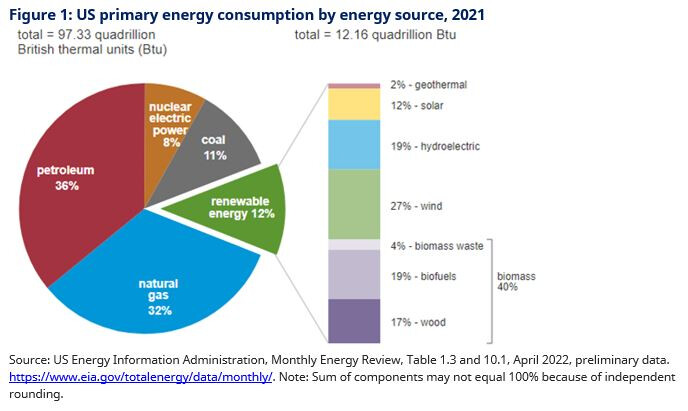Electricity generated from renewables surpassed coal in the United States for the first time in 2022, the U.S. Energy Information Administration announced Monday.
Renewables also surpassed nuclear generation in 2022 after first doing so last year.
Growth in wind and solar significantly drove the increase in renewable energy and contributed 14% of the electricity produced domestically in 2022. Hydropower contributed 6%, and biomass and geothermal sources generated less than 1%.
“I’m happy to see we’ve crossed that threshold, but that is only a step in what has to be a very rapid and much cheaper journey,” said Stephen Porder, a professor of ecology and assistant provost for sustainability at Brown University.
California produced 26% of the national utility-scale solar electricity followed by Texas with 16% and North Carolina with 8%.
The most wind generation occurred in Texas, which accounted for 26% of the U.S. total followed by Iowa (10%) and Oklahoma (9%).
…
“Renewable energy is now the most affordable source of new electricity in much of the country,” added Wetstone.
…
This presents challenges for engineers and policy-makers, Porder said, because existing energy grids were built to deliver power from a consistent source. Renewables such as solar and wind generate power intermittently. So battery storage, long-distance transmission and other steps will be needed to help address these challenges, he said.
The EIA report found the country remains heavily reliant on the burning of climate-changing fossil fuels. Coal-fired generation was 20% of the electric sector in 2022, a decline from 23% in 2021. Natural gas was the largest source of electricity in the U.S. in 2022, generating 39% last year compared to 37% in 2021.
#
Solar and wind and other clean sources generated 38% of the world's electricity in 2021.
For the first time wind turbines and solar panels generated 10% of the total. https://t.co/UozP0m76eL
— Vala Afshar (@ValaAfshar) March 30, 2022
Page 182 Green Fraud:
Passing Wind
In 2020 climate activist Bill McKibben claimed, “In the last 10 years, engineers have driven the price of sun and wind power down below coal.” But H. Sterling Burnett, an energy policy analyst at the Heartland Institute, explained why McKibben’s claim was not accurate. “What McKibben doesn’t disclose is that he’s only counting the price of wind and solar on days when they are operating at peak capacity, while ignoring their capital costs,” Burnett wrote.
“The fact that wind and solar produce so little of the world’s electricity mix is proof positive that they are substantially more expensive than conventional energy,” Burnett explained. “McKibben also conveniently fails to count the tremendous subsidies wind and solar power received from the government. Indeed, without government subsidies and mandates, wind and solar power would largely be a boutique power supply for the wealthy,” Burnett explained.
King Coal: ‘It takes 79 solar workers to produce same amount of electric power as one coal worker’
In an April 25 New York Times article (“Today’s Energy Jobs Are in Solar, Not Coal“) reporter Nadja Popovich wrote that “Last year, the solar industry employed many more Americans [373,807] than coal [160,119], while wind power topped 100,000 jobs.” Those energy employment figures are based on a Department of Energy report (“U.S. Energy and Employment Report“) released earlier this year…
Despite a huge workforce of almost 400,000 solar workers (about 20% of electric power payrolls in 2016), that sector produced an insignificant share, less than 1 percent, of the electric power generated in the United States last year (EIA data here). And that’s a lot of solar workers: about the same as the combined number of employees working at Exxon Mobil, Chevron, Apple, Johnson & Johnson, Microsoft, Pfizer, Ford Motor Company and Procter & Gamble. In contrast, it took about the same number of natural gas workers (398,235) last year to produce more than one-third of U.S. electric power, or 37 times more electricity than solar’s minuscule share of 0.90 percent. And with only 160,000 coal workers (less than half the number of workers in either solar or gas), that sector produced nearly one-third (almost as much as gas) of U.S. electricity last year.
The goal of America’s energy sector isn’t to create as many jobs as possible (as the NYT article would apparently have us believe) especially the politically-favored and heavily-subsidized renewable energy jobs. Rather, the economic goal is to produce as much electric power as possible at the lowest possible cost, and that means we want the fewest number of energy workers!

Despite Green Hype, Coal Still Makes 55 Times More Power Than Solar





